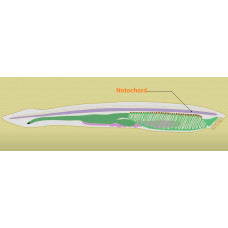Greek χορδή, "string," dorsal string, notochord.
The notochord is a strong and flexible formation that extends from the head to the tail; it is well developed in adult round-bodied and some bony fishes and performs the function of supporting and maintaining the correct shape of the body during movement. In cuttlefish, bivalves and sturgeons, the notochord is preserved as a continuous, undivided cord within a dense sheath of connective tissue. In cartilaginous and bony fishes, the notochord penetrates the entire vertebral column, widening between the bodies of adjacent vertebrae and narrowing to form a channel through the centre of the vertebral body.
During embryonic development, the notochord is present in all chordates. In some crustaceans (appendicularia), in craniofossils (lanceolate) and in some vertebrates (roundworms, fishes - in wholeheaded fishes, cartilaginous gnathostomes and bipedal fishes), the notochord is preserved throughout life.
Notochord sturgeon is used for food.
Notochord
Tags: notochord

